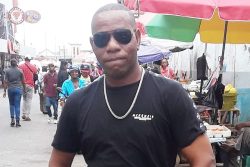– Director of Culture counters that minister’s oversight is not a new process
Renowned Guyanese artist Stanley Greaves has voiced deep concerns regarding the apparent removal of Ohene Koama’s responsibilities as curator of the National Collection but Director of Culture Tamika Boatswain has denied this stating that the artist is referencing an “administrative process that has been in place since this administration got into office”.
Greaves shared his dismay over recent developments, stating, “My intention to hold an exhibition at Castellani House was met with surprise when I was told to approach the minister instead of the curator. That’s not how this should work.”
Greaves, a key figure in Guyana’s artistic landscape and one of the contributors to the design of the nation’s coat of arms, argued that this decision undermines the artistic integrity of the country’s cultural institutions.
Greaves, who previously served on the Castellani House Committee, contended that removing that responsibility from Koama was a significant misstep. He asserted that a curator plays a vital role in overseeing exhibitions, a responsibility that should not be transferred to Minister of Culture, Youth and Sport Charles Ramson. “He [Koama] is the person to give permission, not the minister. That’s not the minister’s job,” Greaves stated emphatically to Stabroek News yesterday, emphasizing the necessity of preserving the curator’s autonomy.
Boatswain contacted Stabroek News last evening at the behest of Ramson to offer an explanation in response to a letter to the editor written by Greaves. “It is the position of the ministry that Mr Koama is still very much involved and is a part of the decision-making processes of the National Art Gallery,” Boatswain said in a telephone call. “What Mr Greaves is referring to is simply an administrative process that has been in place since this administration got into office. We have not turned down any artist who has applied using this process. This is in an effort for the ministry to ensure the quality of art pieces shown at the Art Gallery maintains the standard required, and this applies to small artists and established ones. This process of the applications going to the ministry does not override the decision-making capacity of the curator. The curator and the manager of any of the facilities are all actively involved every step of the way.” Koama was also on the call and agreed with Boatswain’s statement.
The Director of Culture was asked about Greaves’s statement about the need to “reinstitute the Castellani House Committee which in the past has been very supportive at all levels relating to the administration of Castellani House”. To this, Boatswain said, “There is no legal basis for a board to be instituted, there is no act to support this. The presence of a board is based solely on the decision of the minister.”
Greaves’s letter titled “I will not have a 90th birthday exhibition as I will not endorse Ramson’s dictatorial behaviour” highlighted Koama’s challenges, noting that he is currently working alone under stressful conditions without adequate support. “He’s doing the work of many, yet he has no one to lean on. The pressure is too much,” Greaves lamented. He called for the reinstitution of the Castellani House Committee to assist Koama and ensure the smooth operation of the gallery. “We used to have discussions to make sure that everything was functioning properly. Now he’s all on his own, and that’s simply not sustainable,” he added.
Reliable sources have indicated that the Ministry of Culture has adopted a new policy. “The ministry decided to approve exhibitions for the gallery, which is a responsibility that was previously handled by the gallery itself,” sources said. They explained that artists would usually engage the gallery directly, allowing curators to assess the work and determine readiness for exhibition. This shift has raised concerns among many in the art community, who fear it diminishes the curator’s role.
Beyond administrative concerns, Greaves acknowledged Koama’s long-standing contributions to Guyana’s artistic community. He credited the curator with facilitating international exhibitions and nurturing local talent. “He’s been doing that for decades. His understanding of our national collection is unparalleled. I am not aware that Ramson knows the content of the national collection… either in part or in whole. The curator must be the one to assess and judge art, not someone without that background, ” Greaves said. “This kind of interference feels like a power grab. It shows a lack of respect for the established roles that help our art community thrive.
“We need leadership that values artistic integrity and respects the people who work tirelessly to promote our culture. It’s about preserving our heritage and ensuring our artistic institutions can grow. We cannot afford to let the cultural fabric of our nation unravel.”









